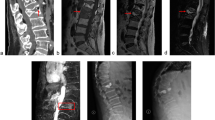Abstract
Introduction
The relevance of blood supply for bone fracture healing has been discussed throughout the literature, using scaphoids as the most referred to. But, there is virtually nothing known about the relevance of blood supply for the vertebral fracture healing and even the guidelines of AO do not deal with this issue.
Materials and methods
A prospective cohort study of 107 patients was run from January 2016 to December 2016, with 54 male and 53 female patients, who were treated for traumatic vertebral fractures of thoracolumbar spine using posterior stabilization only. The average age was 67 years and the follow-up 12.3 weeks. The total number of vertebrae was 129. We analyzed the fracture morphology and measured the vertebral bodies in all three dimensions, with five reference planes. The progress of vertebral deformity in time measured before and after the surgery was correlated with the potential damage of the main vascular canal in the rear of each vertebral body. The bone pattern and morphology were analyzed in detail as well. Pathological fractures were not taken into our consideration.
Results
The overall deformity progression of vertebral bodies in the fractures with morphologically damaged blood supply was in all measured dimensions significantly higher than in the fractures with supposedly maintained perfusion. The osteoporosis played its role as well, but only with medium effect size compared with strong effect size of the vessel canal damage (Cohen). The combination of the both factors (damage to the vessel canal together with osteoporosis) showed also a strong correlation with a relevant deformity progression (Evans), but not much different from the vessel canal damage alone. With regard to the relevant changes of the vertebral body dimensions/volume, we found relevant changes in 52% of all fractures (SD 0.5017) generally, for the subgroup with the canal damage in 84% (SD 0.3691), with strong correlation (Evans, 0.7721). In the group of fractures with maintained perfusion, we found such changes in only in 5% of fractures (SD 0.2333).
Conclusion
For decision making, we should take mechanical fracture analysis and dynamic processes within traumatized tissue a part of whose is the blood supply and oxygenation into surgical consideration. We recommend anterior rather than posterior stabilization for the cases with damaged vessel canal, and the vertebroplasty could pose an alternative in the elderly.









Similar content being viewed by others
References
Kahl T, Razny FK, Benter JP, Mutig K, Hegenscheid K, Mutze S, Eisenschenk A (2016) Orthopäde Diagnostik des Skaphoids, Fraktur, Pseudarthrose, Durchblutung, Perfusion. Orthopäde 45:938–944
McCormack T, Karaikovic E, Gaines RW (1994) The load sharing classification of spine fractures. Spine 19:1741–1744
Oner FC, van Gils APG, Dhert WJH, Verbout AJ (1999) MRI findings of thoracolumbar spine fractures: a categorization based on MRI examinations of 100 fractures. Skelet Radiol 28:433–443
Reinhold M, Audige L, Schnake KJ, Bellabarba C, Dai LY, Oner FC (2013) AO spine injury classification system: a revision proposal for the thoracic and lumbar spine. Eur Spine J 22:2184–2201
Spiegl UJA, Jarvers JS, Heyde CE, Glasmacher S, Von der Höh N, Josten C (2015) Zeitverzögerte Indikationsstellung zur additiv ventralen Versorgung thorakolumbaler Berstungsfrakturen: Welcher Korrekturverlust ist zu erwarten. Unfallchirurg 119:664–672
Zhang YL, Shi LT, Tang PF, Sun ZJ, Wang YH (2017) Correlation analysis of osteoporotic vertebral compression fractures and spinal sagittal imbalance. Orthopäde 46:249–255
Author information
Authors and Affiliations
Corresponding author
Ethics declarations
Conflict of interest
There is no conflict of interest in this study for all authors.
Ethical standard
All procedures performed in studies involving human participants were in accordance with the ethical standards of the institutional and/or national research committee and with the 1964 Helsinki Declaration and its later amendments or comparable ethical standards. For this type of descriptive study, formal consent is not required.
Rights and permissions
About this article
Cite this article
Hajnovic, L., Sefranek, V. & Schütz, L. Influence of blood supply on fracture healing of vertebral bodies. Eur J Orthop Surg Traumatol 28, 373–380 (2018). https://doi.org/10.1007/s00590-017-2069-7
Received:
Accepted:
Published:
Issue Date:
DOI: https://doi.org/10.1007/s00590-017-2069-7




